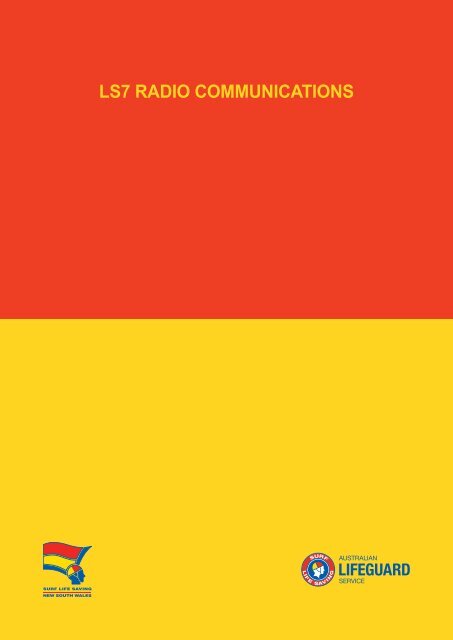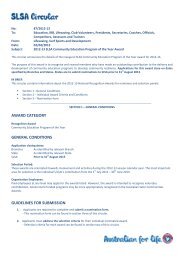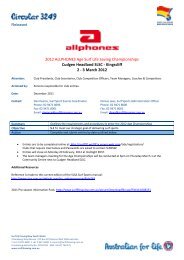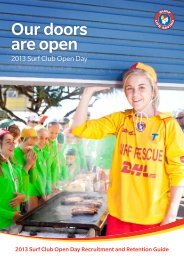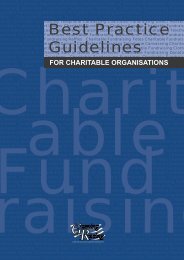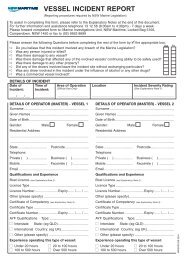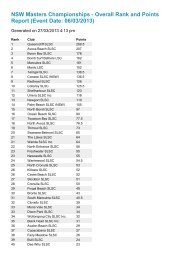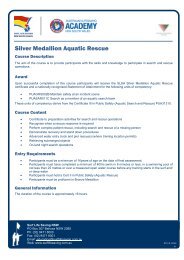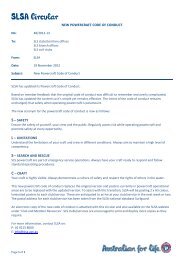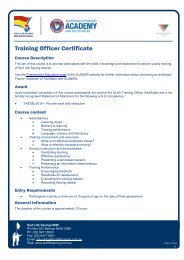LS07. Radio Communications - Surf Life Saving NSW
LS07. Radio Communications - Surf Life Saving NSW
LS07. Radio Communications - Surf Life Saving NSW
- No tags were found...
Create successful ePaper yourself
Turn your PDF publications into a flip-book with our unique Google optimized e-Paper software.
LS7.2 RADIO SPECIFICATIONSSection: LS7 <strong>Radio</strong> <strong>Communications</strong> Page: 1 of 3Date: 22 nd September 2012PurposeTo outline minimum radio specifications for SLS radios used in <strong>NSW</strong>.DefinitionsBase-set/Mobile-Set:Portable/Handheld:Fixed radio unit-usually located in towers/clubs or ATV/4WD<strong>Radio</strong> units used/carried by individual lifesavers/lifeguards<strong>Life</strong>saving Operations: Patrolling/Emergency Response/Training/Events/CarnivalsPolicy1. Only SLS<strong>NSW</strong> approved radio makes or models shall be utilised for lifesaving operations.2. <strong>Radio</strong>s for lifesaving operations shall be purchased only from SLS<strong>NSW</strong> approved suppliers/dealers andmust be Australian type approved radios.3. Only SLS<strong>NSW</strong> approved radio service agents shall be authorised to service or program SLS radios.4. SLS radios shall only have the SLS<strong>NSW</strong> schedule of radio frequencies/channels programmed into them(additional frequencies must have SLS<strong>NSW</strong> written approval and subsequent records updated on theSLS<strong>NSW</strong> frequency schedule).5. No one other than authorised SLS<strong>NSW</strong> personnel shall provide SLS<strong>NSW</strong> frequencies to other parties, andno other radios other than SLS radios shall hold SLS<strong>NSW</strong> frequencies without SLS<strong>NSW</strong> approval in writing.6. External (non SLS) services with authorisation to hold SLS frequencies shall reapply to SLS<strong>NSW</strong> annually.7. SLS clubs/services shall service all radio equipment annually, including frequency/channel alignment.8. Only those ‘special functions’ approved by SLS<strong>NSW</strong> and provided to endorsed radio suppliers/serviceagents shall be activated on SLS radios.9. SLS services shall utilise only radios which meet the following specifications to ensure optimal workingability within the SLS<strong>NSW</strong> radio network for lifesaving operations.<strong>Radio</strong> Equipment Minimum Requirements:Spectrum<strong>Radio</strong> Type<strong>Radio</strong> ModeFrequency RangePower OutputChannel SpacingChannelsChannel SelectionSignalingUHFBase-set/Mobile-Set or Portable/hand-heldConventional/PMRUHF 450–520MHz (UW)4 Watt (portable/handheld)25 Watt (base-set/mobile-set)12.5 kHz (narrow)50 + minimum100 + recommendedPush button with LCD (> 50 channel)5 Tone (CCIR) Selcall ANI capableCTCSS encode/decode (sub-tone) capableLS7. <strong>Radio</strong><strong>Communications</strong>STANDARD OPERATING PROCEDURES LIFESAVING SERVICES | 99
LS7.2 RADIO SPECIFICATIONSSection: LS7 <strong>Radio</strong> <strong>Communications</strong> Page: 2 of 3Date: 22 nd September 2012ComplianceVotingScanBackground ScanTX TimeoutTX ReclaimTX LockoutEnvironmentalNumeric KeypadC Tick approval requiredCapableCapableCapableCapableCapableCapableIP57 minimum (water ingress + dust resistant) IP67recommendedOptional – Duty Officer <strong>Radio</strong>s only8+ hour shift lifeBatteryChargerAccessoriesParts and ServiceScribed2000+ mAhLi-Ion or NiMHSmartOptional external speaker microphone(IP rated)National sales and service (5 years)Permanently marked with club/service name(engraved/other)<strong>Radio</strong> Channel Allocations (branch and club)LS7. <strong>Radio</strong><strong>Communications</strong>Channel # Activity Display DetailsChannel 1 Helicopter 1HELI Simplex Helicopter andemergency workingchannel (on site)Channel 2 Patrol 2PATRL Simplex channel forpatrol dutiesChannel 3 Repeater (Primary) 3Repeater Name Primary/main repeaterchannelChannel 4Priority Scan4SCANOperates as Ch2, but anytransmissions over Ch3Operates as channel 2(repeater) will override(transmit & receive)all other transmissions+ scans Ch1,3 & otheron this channel – sobranch repeaters.emergency calls fromPrioritises Ch3 receive.<strong>Surf</strong>Com are not missedChannel 5-9 Other Branch Repeaters 5Repeater Name North-South100 | STANDARD OPERATING PROCEDURES LIFESAVING SERVICES
LS7.2 RADIO SPECIFICATIONSSection: LS7 <strong>Radio</strong> <strong>Communications</strong> Page: 3 of 3Date: 22 nd September 2012Channel 10 PA Channel 10PA Only if required (requiresSLS<strong>NSW</strong> approval)Channel 11Council <strong>Life</strong>guardChannel11Council nameOnly if required – notrecommended (requiresSLS<strong>NSW</strong> approval)Channel 25-26 Training Channels 25TRAIN Simplex CB trainingchannelThen ALL-STATE repeaters listed as actual repeater channel numbers Nth-SthChannel 41 CUDGEN repeater 41CUDGEChannel 43 ST HELENA repeater 43STHELEChannel 45 BALLINA repeater 45BALLINEtc etc Etc etc Etc etcAny radios with only 16 channels should be phased out (natural attrition), but in the short term will beprovided a special channel plan that includes only branch repeater channels + other branch repeater to thenorth and south.LS7. <strong>Radio</strong><strong>Communications</strong>STANDARD OPERATING PROCEDURES LIFESAVING SERVICES | 101
LS7.3 RADIO EQUIPMENT MAINTENANCESection: LS7 <strong>Radio</strong> <strong>Communications</strong> Page: 1 of 1Date: 22 nd September 2012PurposeTo outline the recommended maintenance procedures for SLS radios.Policy<strong>Radio</strong> Servicing/Preventative MaintenanceAll radio equipment shall be annually serviced by a SLS<strong>NSW</strong> endorsed service agent/technician – to ensurethe integrity of equipment and lifesaving service provision.Equipment needs to be checked for (at a minimum):• Channel/frequency assignment• Battery condition• Transmit power levels• Correct CTCSS number and formatPreseason <strong>Radio</strong> TestsClubs/Services and <strong>Surf</strong>Com’s should conduct a series of preseason radio tests with all lifesaving serviceswithin the <strong>Surf</strong>Com coverage area.Testing should commence no later than one month before the start of the season to enable issues to beidentified and rectified so as to not inhibit lifesaving operations.<strong>Radio</strong> Programming/FrequenciesAll radios shall be programmed only by a SLS<strong>NSW</strong> endorsed licensed technician/agent as per SLS<strong>NSW</strong>specifications and allocations. <strong>Radio</strong> frequencies schedules are maintained by SLS<strong>NSW</strong> and are providedonly to endorsed radio service agents. They shall not be provided to other clubs/services or other bodies/persons. No alterations to radio programming shall be undertaken without SLS<strong>NSW</strong> authorisation – toensure adherence to licenses and to ensure radio channels are correctly documented (SLS<strong>NSW</strong>).LS7. <strong>Radio</strong><strong>Communications</strong>102 | STANDARD OPERATING PROCEDURES LIFESAVING SERVICES
LS7.4 COMMUNICATIONS SECURITY/STREAMINGSection: LS7 <strong>Radio</strong> <strong>Communications</strong> Page: 1 of 1Date: 22 nd September 2012PurposeTo outline expectations and restrictions regarding recording, releasing ans streaming oflifesaving communications.PolicyNo individual club or service shall record, release, publish or stream any surf lifesaving radio, phone orwritten communications without the written authorisation of <strong>Surf</strong> <strong>Life</strong> <strong>Saving</strong> New South Wales.These restrictions include:• Recording of SLS<strong>NSW</strong> radio frequencies and/or provision of recording communications to any otherparty (internal or external).• Live streaming of SLS<strong>NSW</strong> radio frequencies on the internet or any intranet system.• Recording of any lifesaving operations related phone/mobile communications and/or provision to anyother party (internal/external).• Provision of surf life saving logs or forms to any other party (internal/external) – other than <strong>NSW</strong>Police/Coroner.• ‘Posting’ or publishing any official surf life saving logs/forms online or in the media.Social MediaPlease refer to the separate SLSA Social Media Policy.ReferenceSLS<strong>NSW</strong> SOP – Social MediaSLSA Policy 6.20 - Social MediaLS7. <strong>Radio</strong><strong>Communications</strong>STANDARD OPERATING PROCEDURES LIFESAVING SERVICES | 103
LS7.5 RADIO CALL SIGNSSection: LS7 <strong>Radio</strong> <strong>Communications</strong> Page: 1 of 3Date: 22 nd September 2012PurposeTo ensure a consistent and standardised form of communication across <strong>NSW</strong> the following call signs are tobe used by and for all radio communications.ProcedureCallsign: ‘<strong>Surf</strong>Com’ – All radio command centresClubUnitsPatrol Captain or Patrol BaseTower (mobile or fixed)Flagged Area (waters-edge)Roving Foot/ATV PatrolIRB*Call-sign[Club Name] Patrol[Club Name] Tower[Club Name] Flags[Club Name] Roving or Mobile[Club Name] IRB**Additional units assigned numbers. i.e. “[Club Name] IRB1” and “[Club Name] IRB 2.”<strong>Life</strong>guards (ALS)UnitsPatrol BaseTower (mobile or fixed)Flagged Area (waters-edge)<strong>Life</strong>guard RWCRoving Foot/ATV PatrolCall-sign[Beach Name] <strong>Life</strong>guard[Beach Name] Tower[Beach Name] Flags[Beach Name] Support Ski[Beach Name] Roving or Mobile<strong>Life</strong>guard Supervisor [Council Name] 1<strong>Life</strong>guard Supervisor (additional) [Council Name] 2Duty OfficersLS7. <strong>Radio</strong><strong>Communications</strong>Branch/Regional PositionCall-signDuty Officer (in command) [Branch/Council* Name] 10Duty Officer 2 (additional) [Branch/Council* Name] 11Duty Officer 3 (additional) [Branch/Council* Name] 12*In some Branches where responsibility may be divided between Council areas, “Council” may replace“Branch” in the call-sign. i.e Randwick 10Rescue Water Craft Services (Jet Ski)104 | STANDARD OPERATING PROCEDURES LIFESAVING SERVICES
LS7.5 RADIO CALL SIGNSSection: LS7 <strong>Radio</strong> <strong>Communications</strong> Page: 2 of 3Date: 22 nd September 2012UnitCall-signRWC [Branch Name] Support Ski 1*RWC [Branch Name] Support Ski 2*RWC [Branch Name] Support Ski 3*<strong>Life</strong>guard RWC[Beach Name] Support SkiNorth to South Continuous*Branch RWC call-signs apply to a service area, not a specific RWC (item of equipment)*For example if there are 3 RWC services across a branch, the northern service shall assume the call-sign of{Branch Name} Support Ski 1, central service: {Branch Name} Support Ski 2, and southern service {BranchName} Support Ski 3. If the central service was offline, then Support Ski 1 and 3 would be the active servicesthat day.*If more than 1 RWC is operating in an area, they shall assume call-signs of for example:‘{Branch Name} Support Ski 1 Alpha’, and ‘{Branch Name} Support Ski 1 Bravo’SLS<strong>NSW</strong>State PositionCall-signState Duty Officer <strong>NSW</strong> 10Director of <strong>Life</strong>saving <strong>NSW</strong> 11<strong>Life</strong>saving Manager <strong>NSW</strong> 12<strong>Life</strong>saving Officer <strong>NSW</strong> 13<strong>Life</strong>guard Manager <strong>Life</strong>guard 11<strong>Life</strong>guard Coordinator – Northern Region <strong>Life</strong>guard 12<strong>Life</strong>guard Coordinator – Southern Region <strong>Life</strong>guard 13Helicopter/sUnitCall-signSLSQ Gold Coast Helicopter <strong>Life</strong>saver 5SLSQ Gold Coast Helicopter <strong>Life</strong>saver 6Northern Region Helicopter(Lismore)Northern Region Helicopter(Lismore)<strong>Life</strong>saver 2<strong>Life</strong>saver 4Tamworth Helicopter Westpac 3Tamworth Helicopter Westpac 4Hunter Helicopter Westpac 1LS7. <strong>Radio</strong><strong>Communications</strong>STANDARD OPERATING PROCEDURES LIFESAVING SERVICES | 105
LS7.5 RADIO CALL SIGNSSection: LS7 <strong>Radio</strong> <strong>Communications</strong> Page: 3 of 3Date: 22 nd September 2012Hunter Helicopter Westpac 2Sydney Westpac Helicopter <strong>Life</strong>saver 1South Coast Westpac Helicopter <strong>Life</strong>saver 3Police PolAir 1 ContinuousAmbulanceRescue 22,23,24BankstownRescue 26WollongongAerial Shark Patrol (fixed-wing) Airpat 1-3Rescue VesselsUnitCall-signBallina Jet Rescue Boat <strong>Surf</strong> Rescue 40Randwick Offshore Rescue Boat <strong>Surf</strong> Rescue 30Cronulla Offshore Rescue Boat <strong>Surf</strong> Rescue 20Kiama Jet Rescue Boat <strong>Surf</strong> Rescue 50LS7. <strong>Radio</strong><strong>Communications</strong>106 | STANDARD OPERATING PROCEDURES LIFESAVING SERVICES
LS7.6 RADIO CODESSection: LS7 <strong>Radio</strong> <strong>Communications</strong> Page: 1 of 2Date: 22 nd September 2012PurposeTo outline SLS<strong>NSW</strong> endorsed radio codes and the parameters of use in lifesaving operations.PolicyUse of radio codes is not mandatory for lifesaving operations, but if used, shall adhere to the following.Procedure• Any SLS<strong>NSW</strong> services wishing to use radio codes shall adhere to the codes below and shall implementtheir use consistently across the whole service (i.e club).• No alternative ‘codes’ shall be used by lifesaving services on SLS<strong>NSW</strong> frequencies without writtenauthorisation by SLS<strong>NSW</strong>.• <strong>Surf</strong>Com’s shall be aware of radio codes and have ‘the code’ immediately available to referencewhen on-duty.• <strong>Surf</strong>Com Operators and Duty Officers shall be inducted in ‘the code’ during <strong>Surf</strong>Com training.• Club/service personnel should be adequately trained/inducted in the use of codes should that serviceimplement their use.• If in any doubt services/personnel should always revert to standard English (clear and concise sentences).<strong>Radio</strong> CodesCode Meaning Further ExplanationRescueRescueRescueBreakBreakNo DuffPriority 1Priority 2Priority 3Prefix for emergencytransmissions to indicate urgency+ call-signGrouping transmissions together(should always leave a gap after 2different transmissions)A real incident underway during atraining exerciseUrgent taskNon-urgent taskRoutine taskShould prefix every initial ‘Priority 1’ emergency call tonotify/request support.i.e from lifesaver to patrol base/patrol captain or fromclub to <strong>Surf</strong>Com.‘Break break’ can be used to group differenttransmissions together.E.g. “Avoca patrol from <strong>Surf</strong>Com, all copied thankyou. Break break, Copacabana Copacabana patrol thisis <strong>Surf</strong>Com requesting your patrol sign-on, over”The term ‘NO DUFF’ is used when a real incidentis occurring during a training exercise or simulatedevent. Every transmission after “No Duff” is treated aslegit.E.g. “No Duff No Duff No Duff, Rescue Rescue Rescue,<strong>Surf</strong>Com <strong>Surf</strong>Com this is Avoca Beach”Specific tasking that requires immediate attendance– usually involves life-threatening situation/rescue orserious injuries or several patients.Specific tasking that requires lifeguard to provideemergency care or to undertake rescue operations butnot considered life-threatening.Specific task but is not considered urgent. May includeadministrative, logistics requests.LS7. <strong>Radio</strong><strong>Communications</strong>STANDARD OPERATING PROCEDURES LIFESAVING SERVICES | 107
LS7.6 RADIO CODESSection: LS7 <strong>Radio</strong> <strong>Communications</strong> Page: 2 of 2Date: 22 nd September 2012Sign OnSign OffSecure<strong>Radio</strong>sCommencing of duty (start of shift)Ceasing duties (end of shift)Secure radios from public earshotPrefixing non-urgent but sensitive information tobe communicated.LS7. <strong>Radio</strong><strong>Communications</strong>Code Meaning Further Explanation.X Search for submerged patient More details required in transmission.1 On duty and available for tasking2On standby and awaiting further Used during incident/callout to indicate ‘elevatedinstructions at (location) state of readiness’ and/or arrival at incident site.3 On meal break4 Beginning to pack up patrol areaThe lifeguard commences to pack equipment at theend of shift.5Leaving beach, assigned task oruse restroom etcWhen complete – transmits a ‘Code 1.’6 Entering the water for trainingUsed when going for a swim, undertaking water basedtraining.When complete – transmits a ‘Code 1.’7This code means the service or aspect of the service isUnavailable to respond to callscontactable but cannot respond at that time. Offer a(service/equipment)timeframe if possible. i.e Byron Support Ski Code 7.8 Unable to be contacted More details required in transmission.9Entering water toundertake rescue10 Search for missing person in waterProvide details, e.g. location, description, etc.“Code X” may be relevant if confirmed(submerged person).11 Mass Rescue12<strong>Life</strong>saver/<strong>Life</strong>guard in trouble(man-down)Member/staff has been injured, is in physical dangeror is missing. Urgent assistance required. If possiblegive further information – especially location.13 CPR Incident More details required in transmission.14 Deceased Person More details required in transmission.15Undertaking First Aid (non-lifethreatening)16 Shark Sighting17 Shark Attack More details required in transmission.18 Indecent Behaviour More details required in transmission.19Undertaking EnforcementFunction108 | STANDARD OPERATING PROCEDURES LIFESAVING SERVICES
LS7.7 RADIO NETWORK FAULT REPORTINGSection: LS7 <strong>Radio</strong> <strong>Communications</strong> Page: 1 of 3Date: 22 nd September 2012PurposeTo outline the process and roles/responsibilities of lifesaving services and service providers in resolvingradio network issues.PolicyA fully operational and effective radio network is essential to the provision of lifesaving services across thestate. The resolution of radio problems must be undertaken in a coordinated manner, to achieve the mosttime efficient and effective outcome.Procedure<strong>Radio</strong> Network ResponsibilitiesThe following parts of the radio network are managed by the following parties:a) Base sets, handheld radios, facility antennas – Clubs/Services/<strong>Life</strong>guardsb) <strong>Surf</strong>Com facilities/equipment – Branchesc) <strong>Surf</strong>Com phone/fax lines – Branchesd) <strong>Surf</strong>Com internet lines – Branchese) <strong>Radio</strong> Network Repeaters/VOIP – SLS<strong>NSW</strong>f) <strong>Radio</strong> Frequencies – SLS<strong>NSW</strong>g) <strong>Radio</strong> Network SOP’s/Procedures – SLS<strong>NSW</strong><strong>Radio</strong> Transmission Quality Checks – For use by lifesaving servicesSIGNAL STRENGTHLOUD – STRENGTH 5GOOD – STRENGTH 4WEAK – STRENGTH 3VERY WEAK – STRENGTH 2FADING – STRENGTH 1Example: “Reading you Strength 3, with Interference over.”REPORT ON READABILITYCLEARREADABLEUNREADABLEDISTORTEDWITH INTERFERENCE<strong>Radio</strong> Network Maintenance Report FormsFORM 1−−Used by Clubs/Services/<strong>Life</strong>guards to inform Branch/Supervisor of problem.−−Used by Branch/<strong>Life</strong>guard Supervisors to inform State of problem.−−Used by SLS<strong>NSW</strong> to inform service technician of problem.FORM 2−−Used by service technician to inform SLS<strong>NSW</strong> of work undertaken (in conjunction withnetwork drawings).LS7. <strong>Radio</strong><strong>Communications</strong>STANDARD OPERATING PROCEDURES LIFESAVING SERVICES | 109
LS7.7 RADIO NETWORK FAULT REPORTINGSection: LS7 <strong>Radio</strong> <strong>Communications</strong> Page: 2 of 3Date: 22 nd September 2012RADIO NETWORK MAINTENANCE PROCEDURE1. A lifesaving service identifies a problem with their radios:• <strong>Life</strong>saving service undertakes radio checks within its own area on at least 2 handhelds and its base set(simplex, main repeater channel, and alternative repeater channel).• <strong>Life</strong>saving service undertakes radio checks (on main and alternative repeater channels) with <strong>Surf</strong>Comand services to the North and South.• <strong>Life</strong>saving service records the results of these radio checks and contacts its appropriate branch/serviceofficer/lifeguard supervisor.2. The branch officer/lifeguard supervisor completes and sends “Form 1” to experts@surflifesaving.com.auor fax 9471 8001 and calls SLS<strong>NSW</strong> on 9471 8000NOTE: ONLY THE SLS<strong>NSW</strong> LIFESAVING MANAGER CAN ENDORSE REPAIRS TO THE RADIO NETWORK3. SLS<strong>NSW</strong> contacts radio network service technician and provides “Form 1” and a “Form 2” template +radio network drawings. Quote requested for repair. Purchase Order number supplied.4. Service provider provides ‘quote’. SLS<strong>NSW</strong> reviews quote and provides direction on whether to progress.5. Service Provider completes work:• Notifies SLS<strong>NSW</strong> of repair at 9471 8000 & experts@surflifesaving.com.au• Completes “Form 2”• Updates network drawings• Returns “Form 2” + drawings to SLS<strong>NSW</strong> with invoice6. SLS<strong>NSW</strong> advises the lifesaving service officer/supervisor of repair/relevant details and updates its radionetwork records.7. <strong>Life</strong>saving service officer/supervisor notifies their lifesaving service personnel.Reference<strong>Radio</strong> Fault Reporting – ‘Form 1’ and ‘Form 2’LS7. <strong>Radio</strong><strong>Communications</strong>110 | STANDARD OPERATING PROCEDURES LIFESAVING SERVICES
LS7.7 RADIO NETWORK FAULT REPORTINGSection: LS7 <strong>Radio</strong> <strong>Communications</strong> Page: 3 of 3Date: 22 nd September 2012RADIO NETWORK MAINTENANCE PROCEDUREFault Discovered - LocalIDENTIFIED EQUIP ISSUE.Service contacts relevantofficer for equipment serviceFault Discovered - <strong>Surf</strong>Com<strong>Radio</strong> checks withinservice (Simplex, Mainrepeater, Alternativerepeater) – Using 2handhelds and base set.CONTIGENCY PLANImplement contingencyplans<strong>Radio</strong> Checks with clubsthrough all available repeaters.<strong>Radio</strong> checks using at least 2radio consoles.<strong>Radio</strong> Checks (as above)with <strong>Surf</strong>Com and 2 otherpatrols. Results recorded.IDENTIFIED NETWORK ISSUE<strong>Life</strong>saving service contactstheir Sfficer/Supervisor andinforms them of issue andresults of radio checks.Using Duty Officer/Supervisor ascommunications point viaradio. Alternatively viacell phone/phone links to<strong>Surf</strong>Com/Clubs or 000<strong>Surf</strong>Com informs clubs of issuevia phone/cell<strong>Surf</strong>Com informs Branch ofissue and completes Form 1and sends to branch<strong>Life</strong>saving Officer/Supervisor completesForm 1 and contactsSLS<strong>NSW</strong> <strong>Life</strong>saving Officerat 9471 8000Branch sends Form 1 toSLS<strong>NSW</strong> at experts@surflifesaving.com.au orfax at 9471 8001SLS<strong>NSW</strong> contactsService ProviderProvides Form 1 +network drawingsSLS<strong>NSW</strong> informs Branch ofresult/relevant details viaphone + emailKEYLocal <strong>Life</strong>savingService ResponseService Providercompletes workInforms SLS<strong>NSW</strong> ofresult 99718000Officer/Supervisor informs<strong>Life</strong>saving service of the result/relevant details<strong>Surf</strong>Com ResponseOfficer/Supervisor ResponseLS7. <strong>Radio</strong><strong>Communications</strong>Service ProviderState ResponseCompletes Form 2Updates Network DrawingsNORMAL OPS RETURNService Provider ResponseSTANDARD OPERATING PROCEDURES LIFESAVING SERVICES | 111
112 | STANDARD OPERATING PROCEDURES LIFESAVING SERVICES


